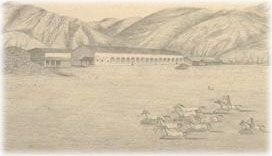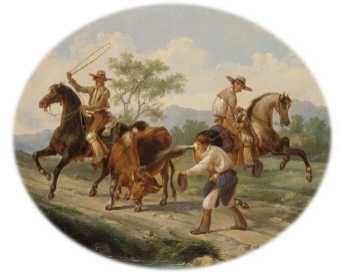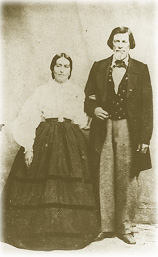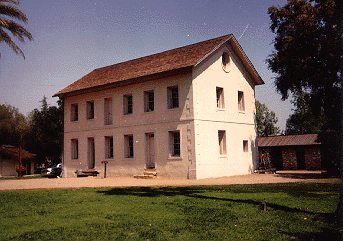|
 |
The History of Rancho Los Encinos
The
site that is now known as Los Encinos was a "rancheria"
(the Spanish term for an Indian village) of the tribe now called
"Fernandeño", "Gabrielino" or Tongva, for several
thousand years. In 1797, when the San Fernando Mission was completed,
the site was largely evacuated.
The
Missions did not use military force to bring Indians into the
Mission, though they would use it to keep them there once they
had converted and become "neophytes". However, the diseases
the white men brought with them, and the destruction of the local
food sources caused by the Mission cattle put the Indians in a
desperate state. A significant majority of the Indians in California
died within a few years of the arrival of the white man from a
combination of disease and starvation. While the padres had the
best of intentions and were horrified at the death they saw around
them, their arrival was the root cause of this inadvertent genocide.
 |
| San Fernando Mission in the Spanish Period |
|
This
disease and starvation did have the effect of forcing most
of the Indians living anywhere near the Spanish settlements,
including those in the San Fernando Valley, to place themselves
under the Mission's protection and control.
When
the Mexican government dissolved the California missions
in 1834, three Mission Indian named Ramon, Francisco and
Roque were given a 4,460 acre rancho (1 Mexican League)
in what was to become Rancho Los Encinos. They and their
families made a marginal living grazing cattle and raising
simple crops. On July 8th, 1845, Governor Pio Pico officially
recognized their claim to the land, but by that time Francisco
and Roque were dead. Their widows inherited the land and
worked it for a few years with Ramon and his family until
1849 when Roman deserted them and his daughter Aguedo, and
ran off to the gold fields. Unable to continue, they sold
out to a Ranchero named Vincente de La Osa (or "de
La Ossa"). |
 |
| Indian Vaqueros lassoing
a steer |
|
Before
California was conquered by the United States in 1847, and
the Gold Rush began in 1849, cattle ranching had been the
center of the entire "Californio" economy. The Californio
"rancheros" raised huge herds of cattle on the
vast grasslands of places like the San Fernando Valley.
The
rancheros and their vaqueros (who were almost all California
Indians) would gather the cattle once a year in a rodeo,
and then slaughter hundreds of them. There was far more
meat than they could eat, so most of the beef was left to
be eaten by the local wildlife, while the rancheros saved
the hides and tallow.
The
hides and tallow would be traded to Yankee sea captains,
who would sail around Cape Horn in ships loaded down with
fabrics, clothes, household goods, liquor and any other
items the Californios might want. The sea captains would
trade their cargo for as many hides and barrels of tallow
as their ships could hold, and then return home to sell
them. The story of one of these voyages is told in the famous
book "Two Years Before the Mast", by Richard Henry Dana.
|
The
De La Osa rancho however, opened just as this phase in California
history was coming to a close. When hundreds of thousands
of gold miners came pouring into California, there were
suddenly enough mouths to eat all the beef this fertile
land could produce, and the meat became more valuable than
the hides. Californio Rancheros like Vincente made a great
deal of money driving their cattle to the gold fields and
selling them there at inflated prices. For a few years,
the Californios prospered under the Stars and Stripes.
In
1849, Vincente De La Osa built the adobe that still stands
at Los Encinos. It is an excellent example of the basic
Californio style of adobe.
It
is long and narrow, with every room having one or more doors
connecting to the outside, and many adjacent rooms not connecting
to each other. Only in a climate as mild as Southern California,
would anyone consider designing a house that way. |
 |
| The De
La Osa Adobe with sheep |
|
 |
| Jim
& Manuela Thomson |
|
The
cattle boom did not last, and when the miners went home
or settled down, the demand for cattle declined. Vincente
compensated by establishing a small vineyard, raising some
sheep, and letting out rooms to travelers. There were many
customers, since the Rancho was located along the primary
road through California, El Camino Real, which in Encino
corresponds to Ventura Blvd. Vincente died in 1861, leaving
his widow Rita with 12 children, and pregnant with a thirteenth.
Rita
managed to hold on for six more years, until 1867 when she
conveyed the 4,460 acre rancho to her son-in-law, Sheriff
James Thomson of Los Angeles and her daughter Manuela for
$3,500. Manuela died in 1868 and the Rancho was sold to
two Frenchmen, Eugene and Phillipe Garnier.
The
Garniers were energetic builders, and added much to the
Rancho. They built a stone-lined pond, in the shape of a
Spanish guitar at the site of the spring; they built a two
story limestone building to serve as a bunkhouse and they
built a roadhouse across the road (Ventura Blvd.) which
became the focal point of the local Basque community.
They
also plunged with both feet into the Los Angeles sheep boom
of the early 1870s. Three years of drought followed by two
years of rain had combined with falling cattle prices to
wipe out the cattle economy in Los Angeles. The sheep moved
in to fill the void.
The
Garniers spent freely on prize Spanish and French Merino
breeding rams and borrowed heavily to finance the expansion
of their herds and facilities. They had the reputation for
producing the finest wool in Southern California.
|
Unfortunately,
it wasn't good enough. The Los Angeles sheep boom was built
on dreams and speculation, and the poor quality of most
of the Southern California product, combined with the expenses
of getting the product back east to the mills, made sheep
ranching on the scale of the Garniers and their many sheep
ranching neighbors, economically insupportable.
The
market collapsed in 1873, and joined with a nation wide
depression to ruin the Garniers and many like them.
They
hung on until 1878, when their primary creditor, a
Basque named Gaston Oxarart, purchased the ranch at a Sheriff's
auction. He continued to raise sheep, but like most landowners
in the Valley, he moved more and more into agriculture.
In 1886, Gaston died, and the ranch passed to his nephew
Simon Gless. In 1889, Gless sold the rancho to his father
in law, Domingo Amestoy. This was the last time the 4,460
acre ranch was sold as a whole. In the coming years, it
would slowly be taken apart, a piece at a time.
In
1916, 1,170 acres of land were sold from the Rancho. This
parcel was subdivided and became the city of Encino.
|
 |
| The Garnier Building |
|
In 1949, through the efforts of Mrs. Mary Stuart in mobilizing
the local community to save the buildings from developers,
the last remaining parcel of land, containing the De La
Osa adobe, Garnier House and spring were purchased by the
State of California, and the Los Encinos State Historic
Park was created. |
